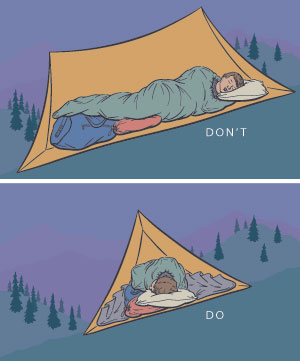
Bedding Down Without the 'Ow'
Get a good night's sleep outdoors by staying dry, comfortable, and on the level.
By Cliff Jacobson
Illustrations by Robert Prince
Camping represents the cornerstone of Scouting: Kids love sleeping on the ground in a tent or under the stars. But for some adults, “sleeping out” doesn’t offer much in the way of an enjoyment.
 They have to pitch the tent, manage the bedrolls, and arrange the gear. Inevitably, the ground slopes or offers a bunch of lumps. Often, they find that one side of the tent is more comfortable than the other. And then there’s the argument about who sleeps where. Worse, heavy rain can cause a middle-of-the-night washout.
They have to pitch the tent, manage the bedrolls, and arrange the gear. Inevitably, the ground slopes or offers a bunch of lumps. Often, they find that one side of the tent is more comfortable than the other. And then there’s the argument about who sleeps where. Worse, heavy rain can cause a middle-of-the-night washout.
You’re thinking a city-soft body needs at least two nights to adjust to the wild outdoors. Right? Don’t believe it. The key to comfort is how you pitch your tent and prepare your bed. Teens are tough, so your boys will adjust quickly. That means that except on bitter-cold nights, your boys will be comfortable enough without an air mattress or foam pad. But if they do feel cold coming up from the ground, have them place their spare clothes “shoulder-to-thighs” under their sleeping bags.
Tip: If you or your boys want some type of pad, carpet can be an inexpensive substitute.
A SLOPING SITE
Conventional wisdom advises that you pitch your tent with the head end uphill, and then pile clothes under your legs to level the site. But this creates a hammock effect that may produce a morning backache.
A better plan? Pitch the tent perpendicular to the drop (one side lower than the other). Then, level your trail mattress by placing clothes under the downhill side. You’re creating a “level trough” that’s much more comfortable to sleep in than a “hammock.”
Tip: A down vest stuffed into a cotton pillow sack makes a luxurious pillow.
PROTECT AGAINST FLOWING GROUNDWATER
If you’re pitched in a low spot and it rains hard enough, groundwater will flow into your tent. Old-timers controlled water flow by digging a trench around their tent—a procedure that causes serious soil erosion and, consequently, has become illegal everywhere. Instead, place an over-size plastic ground cloth inside your tent. Make the ground cloth large enough to flow about a foot up the sidewalls of your tent.
Any groundwater that gets into your tent will be trapped beneath the plastic sheet, and you’ll stay dry. And unless you want to throw a sponge party, don’t place another ground cloth under the tent floor to protect it from punctures. Groundwater that becomes trapped between the floor and groundsheet below will be pressure-wicked by body weight into your tent.
Tip: Old ideas die hard. You might think it’s crazy to put the ground cloth inside your tent, but try it and you’ll never get wet.
COVER YOUR SLEEPING PAD
On summer nights, you might want to forego the sleeping bag and lay directly on your air mattress or foam pad—except the plastic/nylon covering on these pads becomes too hot and sticky. The solution: Make a fitted-cotton flannel cover for your pad. The cotton wicks away sweat, guards against punctures, and prevents the pad from sliding around on the slick plastic groundsheet below.
Tip: Place your spare clothes along the sides of your mattress so that your arms won’t chill if they fall off the pad.
Cliff Jacobson is a Distinguished Eagle Scout and the author of more than a dozen top-selling outdoors books.